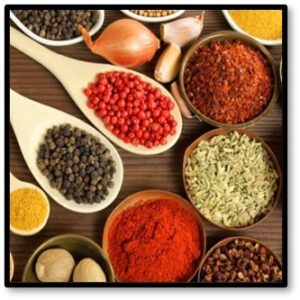Monday Author: Susanne Skinner
“Once you get a spice in your home, you have it forever. Women never throw out spices. The Egyptians were buried with their spices. I know which ones I’m taking with me when I go.” ~ Erma Bombeck
 Spices transform any meal by adding a wide range of nuance and flavor, from a bit of sweetness to full-blown heat. Although we eat first with our eyes, spices give up enticing aromas that influence how we think and feel about the meal we’re about to eat.
Spices transform any meal by adding a wide range of nuance and flavor, from a bit of sweetness to full-blown heat. Although we eat first with our eyes, spices give up enticing aromas that influence how we think and feel about the meal we’re about to eat.
Spices are just dried seeds, roots or flower buds. Herbs come from leaves of plants and used fresh or dried. A chili pepper is dried fruit and the middle eastern spice known as sumac is a dried berry. Choices range from delicate to bold, offering something for everyone’s palette.
Cooking with spices can be intimidating, but a little experimenting broadens your repertoire and rewards you with a delicious flavor journey.
Unlock The Flavor of Food
In my cooking universe spices are front and center for sweet and savory dishes. My husband and I practice healthy eating, and we both agree that healthy eating does not equal bland taste. Fresh food presents a canvas waiting for added flavor and I am not afraid to step outside of my spice comfort zone to find it.
I look for recipes offering complimentary flavor profiles (think basil, oregano and rosemary) as well as those singling out a specific spice, like paprika, for the dominant taste.
Don’t dismiss salt and pepper; these common but often overlooked seasonings are essential to most recipes. Experiment with new varieties and bring added depth to the seasoning table. Consider branching out and discovering the many ways these two seasonings vary the taste of a recipe.
A note to bakers: Kosher salt is recommended for baking; however different brands have different levels of salinity. I prefer the Diamond Crystal brand for baking because Morton’s is about 1.5 times saltier. Make sure to adjust your recipe, as most quantities are based on Morton’s salt.
Spice Blends
 In addition to standalone spices, there are blends that create unique flavor combinations. If you have a favorite store-bought blend, a quick Google search will likely turn up several recipe options. You don’t necessarily save money, but you will taste the difference and know exactly what’s in the jar! Also, you can scale them to smaller quantities that don’t go to waste.
In addition to standalone spices, there are blends that create unique flavor combinations. If you have a favorite store-bought blend, a quick Google search will likely turn up several recipe options. You don’t necessarily save money, but you will taste the difference and know exactly what’s in the jar! Also, you can scale them to smaller quantities that don’t go to waste.
You can purchase bulk spices in some of the larger grocery chains and they are readily available online. Steer clear of the spice aisle in the store whenever possible, it’s expensive and not necessarily your freshest option.
Grind Your Own Spices
I have a high-quality coffee grinder I found at a thrift store that I use just for spice grinding. It’s the perfect tool to create a single spice powder and for blending several spices together.
It’s important to thoroughly clean it each time it’s used, or your homemade taco seasoning will have back notes of Morocco blend.
Blending your own spices is easy and the finished products yield bright, fresh flavors. A general rule of thumb for measuring is one part whole spice yields 1 1/4 to 1 1/2 parts ground spice.
Sweet and Savory
 Food trends come and go, offering unique (and sometimes bizarre) pairings that capture our attention for a hot minute. I’m thinking of pineapple pizza and maple bacon jam. Even beer gets in on the act by adding everything from citrus peel to chili pepper.
Food trends come and go, offering unique (and sometimes bizarre) pairings that capture our attention for a hot minute. I’m thinking of pineapple pizza and maple bacon jam. Even beer gets in on the act by adding everything from citrus peel to chili pepper.
Blending sweet and savory spices is not a new concept, and an adventurous palate can uncover some new and delicious results. The above-mentioned Moroccan spice blend combines cinnamon, allspice, ginger, cayenne and cumin—and it works. A perfect example of how these sweet and savory spices come together is this delicious Moroccan Lamb Kefta.
The Outliers: One-of-a-Kind Spices
Ethnic recipes often call for spices we don’t normally have on hand. When I’m making an investment in an unusual or pricey spice, I look for the smallest size available. This can be driven by cost, like Saffron, infrequent use like Sumac, or specific ethnic recipes like Za’atar.
After I make a purchase, I look for recipe options to expand the use of that spice. For example, saffron’s primary use is middle-eastern cooking, but its unique flavor also shines in bread.
A word of caution when purchasing spices: check the origin and authenticity. True Za’atar is a blend of hyssop, sumac and sesame seed but today most za’atar blends are herbs like oregano, marjoram, and thyme—not real za’atar, This is because the za’atar plant is a protected species, only harvested at certain times of the year to prevent extinction.
Homemade Vanilla
Vanilla beans continue to rise in price, but they’re a level up for bakers who want to make homemade vanilla. It’s worth the investment and let’s be honest, the store-bought brands aren’t cheap or high quality. Make your own to discover what you’re missing.
I make both Tahitian and Madagascar vanilla and my favorite web site for ordering all things vanilla, including the beans, is Beanilla. Buy the best beans you can afford and the cheapest vodka you can find. This recipe gives step-by-step instructions and produces intensely flavored vanilla. I let mine sit for at least four months –two months longer than the recipe recommends.
Online Resources
The taste, smell and texture of quality spices reflect the finished product. If you’re new to cooking with spices this chart offers a good introduction to flavor profiles and uses.
Don’t be intimidated by unfamiliar spices and bold flavors. Start slowly, tasting after each addition to keep the ingredients balanced. Discover unique aromas and taste experiences in each meal you prepare.
 Mail ordering spices is an excellent purchasing option. These three companies do not disappoint; all of them offer excellent value for money and quality ingredients.
Mail ordering spices is an excellent purchasing option. These three companies do not disappoint; all of them offer excellent value for money and quality ingredients.
In cooking as in life, spice it up!
